Music Elements
Pitch
Pitch is how high or low a tone is. You may hear people refer to “register” when talking about pitch.
Scales are formed by organizing pitches into a pattern of intervals between them. You will hear scales described as major/minor, chromatic, gapped.
Harmony is formed by patterns of chords. You will hear Harmony described as major/minor, dissonant, consonant, tonal, atonal, triadic, functional.
Chords are meaningful groups of tones within a harmonic system.
Key is a group of notes based on a particular note and comprising a scale, regarded as forming the tonal basis of a piece or passage of music.
Rhythm
Rhythm the time element of music.
A specific rhythm is a specific pattern in time. We usually hear these in relation to a steady pulse, and mentally organize this pulse or tempo into meter (sometimes called a "time signature").
Meter organizes beats into groups, usually of two or three.
Beats can be divided into small units, usually 2, 3 or 4 subdivisions.
Melody
Melody is a combination of pitch and rhythm (some say "duration"). Melody is also called musical line.
Sometimes a melody is considered to be the theme of a composition.
We might characterize melody by its contour (rising or falling) and the size of the intervals in it.
A melody that uses mostly small intervals (or scale steps) and is smooth is said to be a conjunct melody.
A melody that uses large intervals is called a disjunct melody.
A motif (or motive) is either a very short melody or a distinctive part of a longer melody.
Example: the opening four notes of Beethoven's Fifth Symphony is a "motific cell."
Timbre
Timbre is sound quality or tone color.
Timbre is the characteristic that allows us to distinguish between one instrument and another, and the difference between vowel sounds (for example, long "a" or "ee").
You will hear people describe timbre as bright, dark, brassy, reedy, harsh, noisy, thin, buzzy, pure, raspy, shrill, mellow, strained.
Describe timbre by naming an instrument, once you learn the names and sounds of a few instruments.
Dynamics
Dynamics - loud or soft.
A composition that has extremely soft passages as well as extremely loud passages is said to have a large or wide dynamic range.
Dynamics can change suddenly or gradually (crescendo, getting louder, or decrescendo, getting softer.)
Texture
Texture is a quality of the number of lines and the character of their relationship to each other in music.
Monophonic (one voice or line),
Polyphonic (many voices, usually similar, as in Renaissance or Baroque counterpoint),
Homophonic (1. a melody with simple accompaniment; 2. chords moving in the same rhythm (homorhythmic))
Heterophony – “mixed” or multiple similar versions of a melody performed simultaneously (rare in European music; possibly used in Ancient Greece)
Polyrhythmic – characterized by layers felt in different meters simultaneously
Collage – juxtaposition and superimposition of extremely different textures or sounds
In addition to these terms, a texture may be described as light or heavy, thin or thick, or transparent/translucent or dense/opaque.
You already use music elements
As you can tell, you already use music elements, even without knowing the definitions.
Gaining understanding of these terms will help you make your music better by being able to identify specific elements to develop.
Another great benefit of knowing and understanding music elements is how easy it becomes to work with others in the music world.
Music World Common Language
As an artist, producer, musician, you already share the common language of music with others in the music world.
Knowing and understanding the music elements helps your mastery of the music language and makes it easier to communicate with others like you.
Enhance your music journey
I started my music journey in rhythm.
I did not know how to define rhythm or even how to properly describe it. I just knew how to do it.
As a child, I knew how to make and keep specific patterns in time, naturally, using my hands on any surface that would give a sound.

Years later, I taught myself how to play drums and landed my first “gig” as a drummer for the United States Air Force Academy Cadet Gospel Choir. (I auditioned for the Drum and Bugle Corps, but didn't make it. I could not read drum sheet music.)
All the while, I was using all of the music elements as a radio DJ, rapper, singer (choir), dancer and musician.
I greatly improved my natural abilities as I learned and understood the music elements. This enhanced my music journey, allowing me to travel around the United States making music and continue to make music that travels around the world.
Enhance your music journey by learning the music elements and applying what you learn today.
Grace and Peace!
Taurus
